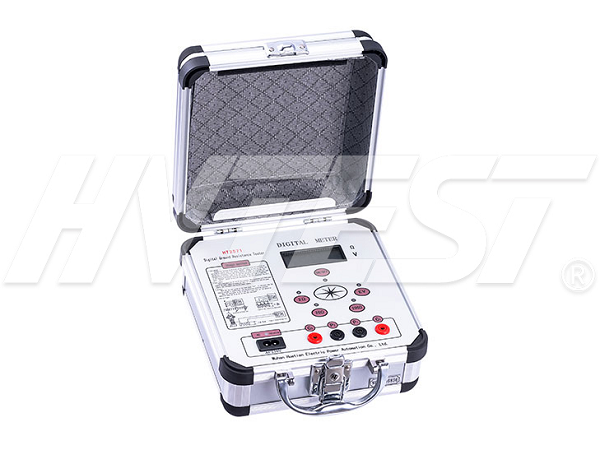Detection Technology
Grounding resistance tester operation problems
Answers to the operation problems of the ground resistance tester
1. Why is the resistance value larger than the ground resistance when measuring the grounding of high-rise buildings. And it shows that the data is severely bounced. What caused it and how to avoid it?
This is because there is a certain resistance between the ground lead of the high-rise building and the ground during high-rise building measurement (R ground wire). In addition, the test line connected from the measurement point on the high-rise building to the ground instrument exists in the air. Line inductance. (WL) So the measured resistance value of the ground point of the high-rise building is R=R ground wire+WL+R ground. Ground resistance R=R ground.
The measurement data of the ground resistance tester is more severe than the ground measurement. This is because the test line is lengthened in the air, like an antenna that leads some radio signals and electromagnetic clutter in the air to the instrument through the test line, causing serious interference. To make the measurement data jump, the solution is to use a coaxial wire as the test lead, connect the coaxial wire and the core wire together, and connect them to the test point. Connect the shielded wire at the other end of the coaxial cable to the C2 end of the instrument (current pole), and connect the core wire of the coaxial cable to the P2 end of the instrument (voltage pole), which can better solve the problem of measuring high-level grounding The resistance is caused by interference due to the long lead.
2. Can the ground terminal of the protected electrical equipment be tested without disconnection? What impact will it have on the test instrument or the protected electrical equipment?
Under normal circumstances, the ground resistance tester requires the equipment to be protected to be disconnected from its grounding terminal when testing the ground resistance. This is because if the protected electrical equipment is not disconnected, the ground resistance is too large or the contact is not good. The voltage or current applied by the meter to the ground terminal of the grounding resistance tester will flow back into the protected electrical equipment. If some equipment cannot resist the voltage and current reversed by the meter, it may cause damage to the electrical equipment. Other electrical equipment will cause leakage due to current leakage. Leakage current enters the meter through the test line and burns out the meter. Therefore, it is generally required to disconnect the protected electrical equipment. In the case of good grounding, measurement can be performed without disconnecting the protected electrical equipment.
3. Why can't the C2P2 and C1P1 of the ground resistance meter be interchanged?
Since the internal circuit design principle C2 of the earth resistance meter is the test pole quasi-potential, which must be strictly equal to the latter reference, it must be directly connected to the electrode of the ground grid under test. P1 and P2 are signal channels. The two can be interchanged. C2 and C1 is not interchangeable.
4. What factors affect the measurement of soil resistivity?
The soil resistivity not only varies with the type of soil, but also varies with temperature, humidity, salt content, and soil compactness.
5. When measuring the ground resistance, what factors cause the ground resistance to be inaccurate and how to avoid it?
A) The contact resistance between the test clip and the ground measurement point is too large. The solution is to polish the contact points with a file or sandpaper, and fully clamp the polished contacts with a test wire clamp.
B) Interference influence. The solution is to adjust the line-out direction and try to avoid the direction with large interference to reduce the bounce of the meter reading.
C) Problems with meter usage. The battery is low, the solution is to replace the battery. If the meter level drops, the solution is to recalibrate to zero.
D) The surrounding soil composition of the grounding system (ground network) is inconsistent, the geology is different, the tightness, the degree of dryness and wetness are different, and it is dispersive. The stray current on the ground surface, especially the overhead ground wire, underground water pipe, cable sheath, etc. The test has a particularly large impact. The solution is to take different points for measurement and take the average value.
E) The direction of the test line is wrong and the distance is not long enough. The solution is to find the test direction and distance.
F) The auxiliary grounding electrode resistance is too large. The solution is to pour water on the ground pile or use a resistance reducer to reduce the grounding resistance of the current electrode.
6. Why is the measurement line required to be 20m and 40m when measuring the grounding resistance? What is the difference between it and the clamp-on ground resistance meter?
This is because when measuring the grounding resistance, it is required to measure the resistance between the grounding electrode and the remote grounding electrode with zero potential. The so-called remote refers to a distance. Under this distance, the mutual resistance of the two grounding electrodes is basically zero. The grounding resistance tester is found through experiments that the distance beyond 20m meets this requirement. If the line distance is shortened, the measurement error will gradually increase.
The clamp ground resistance meter can only measure multi-point grounding. The measurement result is the sum of the measured ground electrode and multiple grounding electrodes in parallel. When measuring single-point grounding, an auxiliary electrode should be connected to make the test circuit form a loop, so the measurement error Be bigger. But the operation is convenient.
Maintenance and repair of relay protection tester | 2020/11/14 | reading779time Dry-type transformer core needs to be grounded | 2020/11/13 | reading1112time return


